2.27: Mitosis
- Page ID
- 8924
\( \newcommand{\vecs}[1]{\overset { \scriptstyle \rightharpoonup} {\mathbf{#1}} } \)
\( \newcommand{\vecd}[1]{\overset{-\!-\!\rightharpoonup}{\vphantom{a}\smash {#1}}} \)
\( \newcommand{\dsum}{\displaystyle\sum\limits} \)
\( \newcommand{\dint}{\displaystyle\int\limits} \)
\( \newcommand{\dlim}{\displaystyle\lim\limits} \)
\( \newcommand{\id}{\mathrm{id}}\) \( \newcommand{\Span}{\mathrm{span}}\)
( \newcommand{\kernel}{\mathrm{null}\,}\) \( \newcommand{\range}{\mathrm{range}\,}\)
\( \newcommand{\RealPart}{\mathrm{Re}}\) \( \newcommand{\ImaginaryPart}{\mathrm{Im}}\)
\( \newcommand{\Argument}{\mathrm{Arg}}\) \( \newcommand{\norm}[1]{\| #1 \|}\)
\( \newcommand{\inner}[2]{\langle #1, #2 \rangle}\)
\( \newcommand{\Span}{\mathrm{span}}\)
\( \newcommand{\id}{\mathrm{id}}\)
\( \newcommand{\Span}{\mathrm{span}}\)
\( \newcommand{\kernel}{\mathrm{null}\,}\)
\( \newcommand{\range}{\mathrm{range}\,}\)
\( \newcommand{\RealPart}{\mathrm{Re}}\)
\( \newcommand{\ImaginaryPart}{\mathrm{Im}}\)
\( \newcommand{\Argument}{\mathrm{Arg}}\)
\( \newcommand{\norm}[1]{\| #1 \|}\)
\( \newcommand{\inner}[2]{\langle #1, #2 \rangle}\)
\( \newcommand{\Span}{\mathrm{span}}\) \( \newcommand{\AA}{\unicode[.8,0]{x212B}}\)
\( \newcommand{\vectorA}[1]{\vec{#1}} % arrow\)
\( \newcommand{\vectorAt}[1]{\vec{\text{#1}}} % arrow\)
\( \newcommand{\vectorB}[1]{\overset { \scriptstyle \rightharpoonup} {\mathbf{#1}} } \)
\( \newcommand{\vectorC}[1]{\textbf{#1}} \)
\( \newcommand{\vectorD}[1]{\overrightarrow{#1}} \)
\( \newcommand{\vectorDt}[1]{\overrightarrow{\text{#1}}} \)
\( \newcommand{\vectE}[1]{\overset{-\!-\!\rightharpoonup}{\vphantom{a}\smash{\mathbf {#1}}}} \)
\( \newcommand{\vecs}[1]{\overset { \scriptstyle \rightharpoonup} {\mathbf{#1}} } \)
\( \newcommand{\vecd}[1]{\overset{-\!-\!\rightharpoonup}{\vphantom{a}\smash {#1}}} \)
\(\newcommand{\avec}{\mathbf a}\) \(\newcommand{\bvec}{\mathbf b}\) \(\newcommand{\cvec}{\mathbf c}\) \(\newcommand{\dvec}{\mathbf d}\) \(\newcommand{\dtil}{\widetilde{\mathbf d}}\) \(\newcommand{\evec}{\mathbf e}\) \(\newcommand{\fvec}{\mathbf f}\) \(\newcommand{\nvec}{\mathbf n}\) \(\newcommand{\pvec}{\mathbf p}\) \(\newcommand{\qvec}{\mathbf q}\) \(\newcommand{\svec}{\mathbf s}\) \(\newcommand{\tvec}{\mathbf t}\) \(\newcommand{\uvec}{\mathbf u}\) \(\newcommand{\vvec}{\mathbf v}\) \(\newcommand{\wvec}{\mathbf w}\) \(\newcommand{\xvec}{\mathbf x}\) \(\newcommand{\yvec}{\mathbf y}\) \(\newcommand{\zvec}{\mathbf z}\) \(\newcommand{\rvec}{\mathbf r}\) \(\newcommand{\mvec}{\mathbf m}\) \(\newcommand{\zerovec}{\mathbf 0}\) \(\newcommand{\onevec}{\mathbf 1}\) \(\newcommand{\real}{\mathbb R}\) \(\newcommand{\twovec}[2]{\left[\begin{array}{r}#1 \\ #2 \end{array}\right]}\) \(\newcommand{\ctwovec}[2]{\left[\begin{array}{c}#1 \\ #2 \end{array}\right]}\) \(\newcommand{\threevec}[3]{\left[\begin{array}{r}#1 \\ #2 \\ #3 \end{array}\right]}\) \(\newcommand{\cthreevec}[3]{\left[\begin{array}{c}#1 \\ #2 \\ #3 \end{array}\right]}\) \(\newcommand{\fourvec}[4]{\left[\begin{array}{r}#1 \\ #2 \\ #3 \\ #4 \end{array}\right]}\) \(\newcommand{\cfourvec}[4]{\left[\begin{array}{c}#1 \\ #2 \\ #3 \\ #4 \end{array}\right]}\) \(\newcommand{\fivevec}[5]{\left[\begin{array}{r}#1 \\ #2 \\ #3 \\ #4 \\ #5 \\ \end{array}\right]}\) \(\newcommand{\cfivevec}[5]{\left[\begin{array}{c}#1 \\ #2 \\ #3 \\ #4 \\ #5 \\ \end{array}\right]}\) \(\newcommand{\mattwo}[4]{\left[\begin{array}{rr}#1 \amp #2 \\ #3 \amp #4 \\ \end{array}\right]}\) \(\newcommand{\laspan}[1]{\text{Span}\{#1\}}\) \(\newcommand{\bcal}{\cal B}\) \(\newcommand{\ccal}{\cal C}\) \(\newcommand{\scal}{\cal S}\) \(\newcommand{\wcal}{\cal W}\) \(\newcommand{\ecal}{\cal E}\) \(\newcommand{\coords}[2]{\left\{#1\right\}_{#2}}\) \(\newcommand{\gray}[1]{\color{gray}{#1}}\) \(\newcommand{\lgray}[1]{\color{lightgray}{#1}}\) \(\newcommand{\rank}{\operatorname{rank}}\) \(\newcommand{\row}{\text{Row}}\) \(\newcommand{\col}{\text{Col}}\) \(\renewcommand{\row}{\text{Row}}\) \(\newcommand{\nul}{\text{Nul}}\) \(\newcommand{\var}{\text{Var}}\) \(\newcommand{\corr}{\text{corr}}\) \(\newcommand{\len}[1]{\left|#1\right|}\) \(\newcommand{\bbar}{\overline{\bvec}}\) \(\newcommand{\bhat}{\widehat{\bvec}}\) \(\newcommand{\bperp}{\bvec^\perp}\) \(\newcommand{\xhat}{\widehat{\xvec}}\) \(\newcommand{\vhat}{\widehat{\vvec}}\) \(\newcommand{\uhat}{\widehat{\uvec}}\) \(\newcommand{\what}{\widehat{\wvec}}\) \(\newcommand{\Sighat}{\widehat{\Sigma}}\) \(\newcommand{\lt}{<}\) \(\newcommand{\gt}{>}\) \(\newcommand{\amp}{&}\) \(\definecolor{fillinmathshade}{gray}{0.9}\)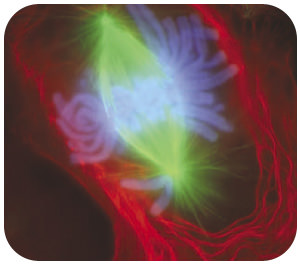
What is meant by the "division of the nucleus"?
What do you think this colorful picture shows? If you guessed that it’s a picture of a cell undergoing cell division, you are right. But more specifically, the image is a lung cell stained with fluorescent dyes undergoing mitosis, during early anaphase.
Mitosis and Cytokinesis
During mitosis, when the nucleus divides, the two chromatids that make up each chromosome separate from each other and move to opposite poles of the cell. This is shown in Figure below.
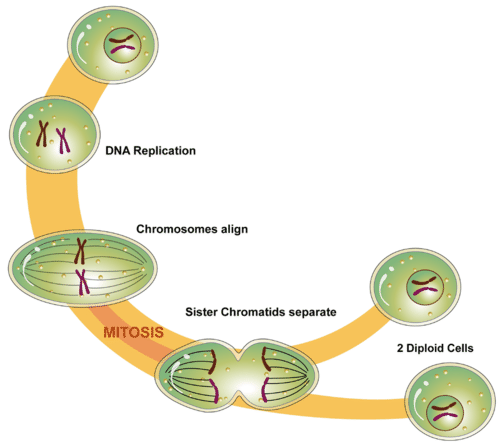 Mitosis is the phase of the eukaryotic cell cycle that occurs between DNA replication and the formation of two daughter cells. What happens during mitosis?
Mitosis is the phase of the eukaryotic cell cycle that occurs between DNA replication and the formation of two daughter cells. What happens during mitosis?Mitosis actually occurs in four phases. The phases are called prophase, metaphase, anaphase, and telophase. They are shown in Figure below and described in greater detail in the following sections.
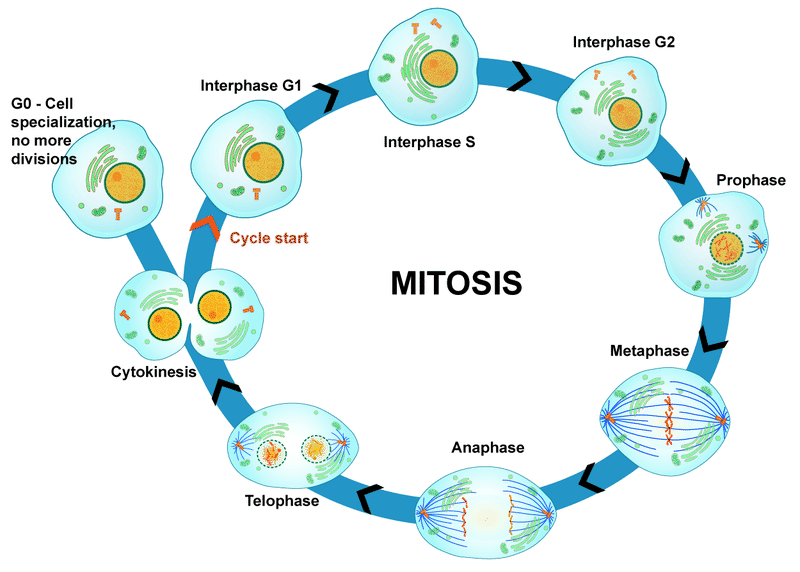 Mitosis in the Eukaryotic Cell Cycle. Mitosis is the multi-phase process in which the nucleus of a eukaryotic cell divides.
Mitosis in the Eukaryotic Cell Cycle. Mitosis is the multi-phase process in which the nucleus of a eukaryotic cell divides.Prophase
The first and longest phase of mitosis is prophase. During prophase, chromatin condenses into chromosomes, and the nuclear envelope, or membrane, breaks down. In animal cells, the centrioles near the nucleus begin to separate and move to opposite poles (sides) of the cell. As the centrioles move, a spindle starts to form between them. The spindle, shown in Figure below, consists of fibers made of microtubules.
 Spindle. The spindle starts to form during prophase of mitosis. Kinetochores on the spindle attach to the centromeres of sister chromatids.
Spindle. The spindle starts to form during prophase of mitosis. Kinetochores on the spindle attach to the centromeres of sister chromatids.Metaphase
During metaphase, spindle fibers attach to the centromere of each pair of sister chromatids (see Figure below). The sister chromatids line up at the equator, or center, of the cell. This is also known as the metaphase plate. The spindle fibers ensure that sister chromatids will separate and go to different daughter cells when the cell divides.
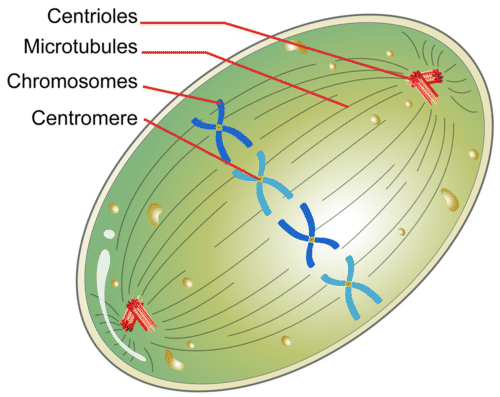 Chromosomes, consisting of sister chromatids, line up at the equator or middle of the cell during metaphase.
Chromosomes, consisting of sister chromatids, line up at the equator or middle of the cell during metaphase.Anaphase
During anaphase, sister chromatids separate and the centromeres divide. The sister chromatids are pulled apart by the shortening of the spindle fibers. This is like reeling in a fish by shortening the fishing line. One sister chromatid moves to one pole of the cell, and the other sister chromatid moves to the opposite pole. At the end of anaphase, each pole of the cell has a complete set of chromosomes.
Telophase
During telophase, the chromosomes begin to uncoil and form chromatin. This prepares the genetic material for directing the metabolic activities of the new cells. The spindle also breaks down, and new nuclear membranes (nuclear envelope) form.
Cytokinesis
Cytokinesis is the final stage of cell division in eukaryotes as well as prokaryotes. During cytokinesis, the cytoplasm splits in two and the cell divides. Cytokinesis occurs somewhat differently in plant and animal cells, as shown in Figure below. In animal cells, the plasma membrane of the parent cell pinches inward along the cell’s equator until two daughter cells form. In plant cells, a cell plate forms along the equator of the parent cell. Then, a new plasma membrane and cell wall form along each side of the cell plate.
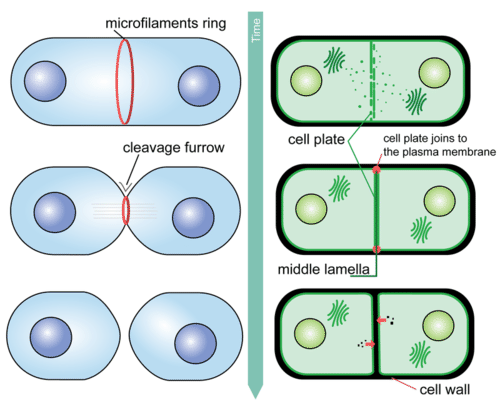 Cytokinesis is the final stage of eukaryotic cell division. It occurs differently in animal (left) and plant (right) cells.
Cytokinesis is the final stage of eukaryotic cell division. It occurs differently in animal (left) and plant (right) cells. The four phases of mitosis. Can you describe what happens in each phase?
The four phases of mitosis. Can you describe what happens in each phase?Summary
- Cell division in eukaryotic cells includes mitosis, in which the nucleus divides, and cytokinesis, in which the cytoplasm divides and daughter cells form.
- Mitosis occurs in four phases, called prophase, metaphase, anaphase, and telophase.
Review
- List the phases of mitosis.
- What happens during prophase of mitosis?
- During which phase of mitosis do sister chromatids separate?
- Describe what happens during cytokinesis in animal cells.
- If a cell skipped metaphase during mitosis, how might this affect the two daughter cells?
- Explain the significance of the spindle fibers in mitosis.
| Image | Reference | Attributions |
 |
[Figure 1] | Credit: User:Kelvinsong/Wikimedia Commons Source: commons.wikimedia.org/wiki/File:Animal_cell_cycle.svg License: Public Domain; CC BY-NC 3.0 |
 |
[Figure 2] | Credit: Mariana Ruiz Villarreal (LadyofHats) for CK-12 Foundation Source: CK-12 Foundation License: CC BY-NC 3.0 |
 |
[Figure 3] | Credit: Zachary Wilson and Mariana Ruiz Villarreal (LadyofHats) (cell images can be found at commons.wikimedia.org/wiki/Us...fHats/gallery2);Zachary Wilson;User:Kelvinsong/Wikimedia Commons Source: CK-12 Foundation ; ck 12 foundation ; commons.wikimedia.org/wiki/File:Animal_cell_cycle.svg License: CC BY-NC 3.0; Public Domain |
 |
[Figure 4] | Credit: Courtesy of Nogales group and Lawrence Berkeley National Laboratory Source: http://www.lbl.gov/Science-Articles/Archive/sabl/2007/Oct/onering.html License: Public Domain |
 |
[Figure 5] | Credit: Mariana Ruiz Villarreal (LadyofHats) for CK-12 Foundation Source: CK-12 Foundation License: CC BY-NC 3.0 |
 |
[Figure 6] | Credit: Mariana Ruiz Villarreal (LadyofHats) for CK-12 Foundation Source: CK-12 Foundation License: CC BY-NC 3.0 |
 |
[Figure 7] | Credit: User:Kelvinsong/Wikimedia Commons Source: commons.wikimedia.org/wiki/File:Animal_cell_cycle.svg License: Public Domain |

